Dual-Module Ultrawide Dynamic-Range High-Power Rectifier for WPT Systems
Abstract
:1. Introduction
2. Microwave Rectifiers for Ultrawide Power Range Operation
2.1. Low-Power, Diode-Based Rectifier Design
2.2. High-Power Class-F HEMT-Based Rectifier Design
3. Experimental Validation
4. Conclusions
Author Contributions
Funding
Data Availability Statement
Conflicts of Interest
References
- Mohamed, A.A.S.; Lashway, C.R.; Mohammed, O. Modeling and Feasibility Analysis of Quasi-Dynamic WPT System for EV Applications. IEEE Trans. Transp. Electrif. 2017, 3, 343–353. [Google Scholar] [CrossRef]
- Chen, H.; Qian, Z.; Zhang, R.; Zhang, Z.; Wu, J.; Ma, H.; He, X. Modular Four-Channel 50 kW WPT System with Decoupled Coil Design for Fast EV Charging. IEEE Access 2021, 9, 136083–136093. [Google Scholar] [CrossRef]
- Jiang, Y.; Wang, L.; Wang, Y.; Liu, J.; Wu, M.; Ning, G. Analysis, Design, and Implementation of WPT System for EV’s Battery Charging Based on Optimal Operation Frequency Range. IEEE Trans. Power Electron. 2019, 34, 6890–6905. [Google Scholar] [CrossRef]
- Zeng, Y.; Qiu, D.; Meng, X.; Zhang, B.; Tang, S.C. Optimized Design of Coils for Wireless Power Transfer in Implanted Medical Devices. IEEE J. Electromagn. Microw. Med. Biol. 2018, 2, 277–285. [Google Scholar] [CrossRef]
- Yang, X.T.; Wong, H.; Xiang, J. Polarization Reconfigurable Planar Inverted-F Antenna for Implantable Telemetry Applications. IEEE Access 2019, 7, 141900–141909. [Google Scholar] [CrossRef]
- Pahlavan, S.; Shooshtari, M.; Jafarabadi Ashtiani, S. Star-Shaped Coils in the Transmitter Array for Receiver Rotation Tolerance in Free-Moving Wireless Power Transfer Applications. Energies 2022, 15, 8643. [Google Scholar] [CrossRef]
- Pahlavan, S.; Jafarabadi-Ashtiani, S.; Mirbozorgi, S.A. Maze-Based Scalable Wireless Power Transmission Experimental Arena for Freely Moving Small Animals Applications. IEEE Trans. Biomed. Circuits Syst. 2024, 1–10. [Google Scholar] [CrossRef] [PubMed]
- Wang, X.; Li, L.; Cui, T.J.; Lu, M. On Differentiation Among Pilot Signals of Multiple Mobile Targets in Retro-Reflective Beamforming for Wireless Power Transmission. Engineering 2023, 30, 55–62. [Google Scholar] [CrossRef]
- Li, X.; Duan, B.; Zhang, Y.; Guo, Y. Optimal Design of Aperture Illuminations for Microwave Power Transmission with Annular Collection Areas. Engineering 2023, 30, 63–74. [Google Scholar] [CrossRef]
- Liu, Z.; Hu, H.; Su, Y.G.; Sun, Y.; Chen, F.; Deng, P. A Double-Receiver Compact SCC-WPT System with CV/CC Output for Mobile Devices Charging/Supply. IEEE Trans. Power Electron. 2023, 38, 9230–9245. [Google Scholar] [CrossRef]
- Peng, C.; Ye, Z.; Wu, J.; Chen, C.; Wang, Z. Design of a Wide-Dynamic RF-DC Rectifier Circuit Based on an Unequal Wilkinson Power Divider. Electronics 2021, 10, 2815. [Google Scholar] [CrossRef]
- Gao, S.P.; Ou, J.H.; Zhang, X.; Guo, Y. Scavenging Microwave Wireless Power: A Unified Model, Rectenna Design Automation, and Cutting-Edge Techniques. Engineering 2023, 30, 32–48. [Google Scholar] [CrossRef]
- Takabayashi, N.; Kawai, K.; Mase, M.; Shinohara, N.; Mitani, T. Large-Scale Sequentially-Fed Array Antenna Radiating Flat-Top Beam for Microwave Power Transmission to Drones. IEEE J. Microw. 2022, 2, 297–306. [Google Scholar] [CrossRef]
- Barnett, R.E.; Liu, J.; Lazar, S. A RF to DC Voltage Conversion Model for Multi-Stage Rectifiers in UHF RFID Transponders. IEEE J. Solid-State Circuits 2009, 44, 354–370. [Google Scholar] [CrossRef]
- Hamill, D. Time reversal duality and the synthesis of a double class E DC-DC converter. In Proceedings of the 21st Annual IEEE Conference on Power Electronics Specialists, San Antonio, TX, USA, 11–14 June 1990; pp. 512–521. [Google Scholar] [CrossRef]
- Abbasian, S.; Johnson, T. Power-Efficiency Characteristics of Class-F and Inverse Class-F Synchronous Rectifiers. IEEE Trans. Microw. Theory Tech. 2016, 64, 4740–4751. [Google Scholar] [CrossRef]
- You, F.; Dong, S.; Wang, Y.; Yu, X.; Li, C. Design Method of Self-Driving RF-DC Rectifier Based on Waveform-Guided Solutions to Passive Matching Network. IEEE Trans. Power Electron. 2019, 34, 6498–6509. [Google Scholar] [CrossRef]
- Abbasian, S.; Johnson, T. High efficiency and high power GaN HEMT inverse class-F synchronous rectifier for wireless power applications. In Proceedings of the 2015 European Microwave Conference (EuMC), Paris, France, 7–10 September 2015; pp. 299–302. [Google Scholar] [CrossRef]
- Roberg, M.; Reveyrand, T.; Ramos, I.; Falkenstein, E.A.; Popovic, Z. High-Efficiency Harmonically Terminated Diode and Transistor Rectifiers. IEEE Trans. Microw. Theory Tech. 2012, 60, 4043–4052. [Google Scholar] [CrossRef]
- Liu, K.; Wang, C.; Zheng, X.; Ma, X.; He, Y.; Li, A.; Zhao, Y.; Mao, W.; Hao, Y. Effect of post anode annealing on W/Au and Ni/Au multi-channel AlGaN/GaN Schottky diode. Superlattices Microstruct. 2021, 160, 107089. [Google Scholar] [CrossRef]
- Takahashi, K.; Ao, J.P.; Ikawa, Y.; Hu, C.Y.; Kawai, H.; Shinohara, N.; Niwa, N.; Ohno, Y. GaN Schottky Diodes for Microwave Power Rectification. Jpn. J. Appl. Phys. 2009, 48, 04C095. [Google Scholar] [CrossRef]
- Zhang, Z.; Cheng, Z.; Fusco, V.; Buchanan, N.; Gu, C. Dual-Band GaN Transistor-Based RF-DC Rectifier. In Proceedings of the 2021 Cross Strait Radio Science and Wireless Technology Conference (CSRSWTC), Shenzhen, China, 11–13 October 2021; pp. 202–204. [Google Scholar] [CrossRef]
- Zhang, J.; Huang, Y.; Zhou, J. A Wide Dynamic Range Rectifier Based on HEMT With a Variable Self-Bias Voltage. IEEE Trans. Circuits Syst. II Express Briefs 2024, 71, 547–551. [Google Scholar] [CrossRef]
- Raab, F. Maximum efficiency and output of class-F power amplifiers. IEEE Trans. Microw. Theory Tech. 2001, 49, 1162–1166. [Google Scholar] [CrossRef]
- Yamazaki, J.; Ishikawa, R.; Honjo, K. Input-Power-Synchronous Adaptively Biased Wide-Dynamic-Range High-Efficiency Rectifier with Zero-Threshold GaAs HEMTs. In Proceedings of the 2020 50th European Microwave Conference (EuMC), Utrecht, The Netherlands, 12–14 January 2021; pp. 436–439. [Google Scholar] [CrossRef]
- UIY. 700 to 5000 MHz—Coaxial Circulator. Available online: https://www.uiy.com/Datasheet/UIYCC2528A.pdf (accessed on 29 May 2024).
- Zhang, Z.; Gu, C.; Cheng, Z.; Xuan, X. Design a GaN HEMT-Based Broadband High-Efficiency Rectifier Using a Wideband Phase Shift Structure. IEEE Microw. Wirel. Technol. Lett. 2023, 33, 751–754. [Google Scholar] [CrossRef]
- Zhang, Z.; Fusco, V.; Cheng, Z.; Buchanan, N.; Gu, C. A Transistor-Based Dual-Band High-Efficiency Rectifier with Dual-Polarity Modes. IEEE Microw. Wirel. Compon. Lett. 2022, 32, 169–172. [Google Scholar] [CrossRef]
- Xiao, Y.Y.; Du, Z.X.; Zhang, X.Y. High-Efficiency Rectifier With Wide Input Power Range Based on Power Recycling. IEEE Trans. Circuits Syst. II Express Briefs 2018, 65, 744–748. [Google Scholar] [CrossRef]
- Zheng, S.Y.; Wang, S.H.; Leung, K.W.; Chan, W.S.; Xia, M.H. A High-Efficiency Rectifier With Ultra-Wide Input Power Range Based on Cooperative Structure. IEEE Trans. Microw. Theory Tech. 2019, 67, 4524–4533. [Google Scholar] [CrossRef]
- Wu, P.; Chen, Y.d.; Zhou, W.; Ren, Z.H.; Huang, S.Y. A Wide Dynamic Range Rectifier Array Based on Automatic Input Power Distribution Technique. IEEE Microw. Wirel. Compon. Lett. 2020, 30, 437–440. [Google Scholar] [CrossRef]
- Kim, J.; Oh, J. Compact Rectifier Array with Wide Input Power and Frequency Ranges Based on Adaptive Power Distribution. IEEE Microw. Wirel. Compon. Lett. 2021, 31, 513–516. [Google Scholar] [CrossRef]

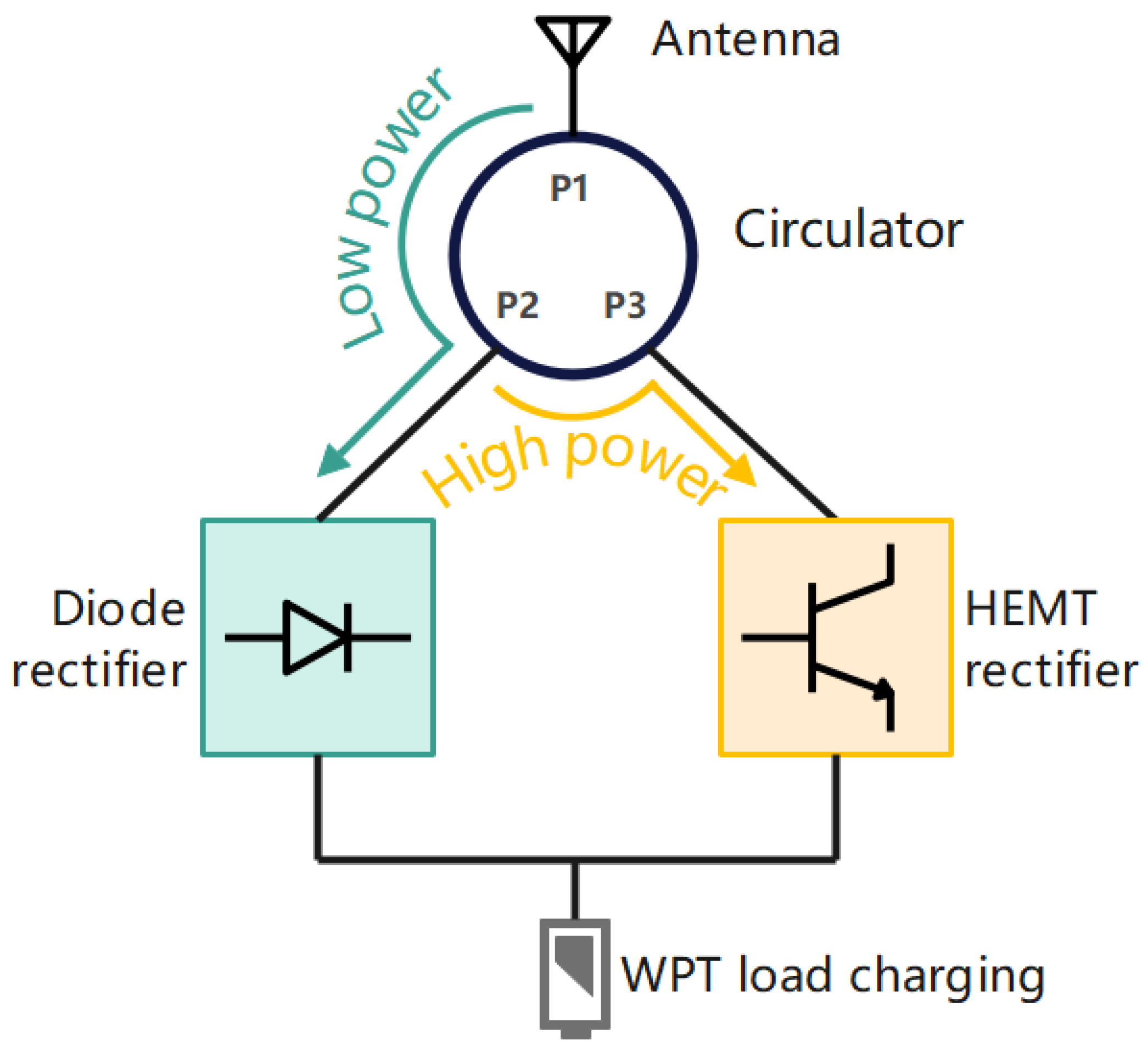
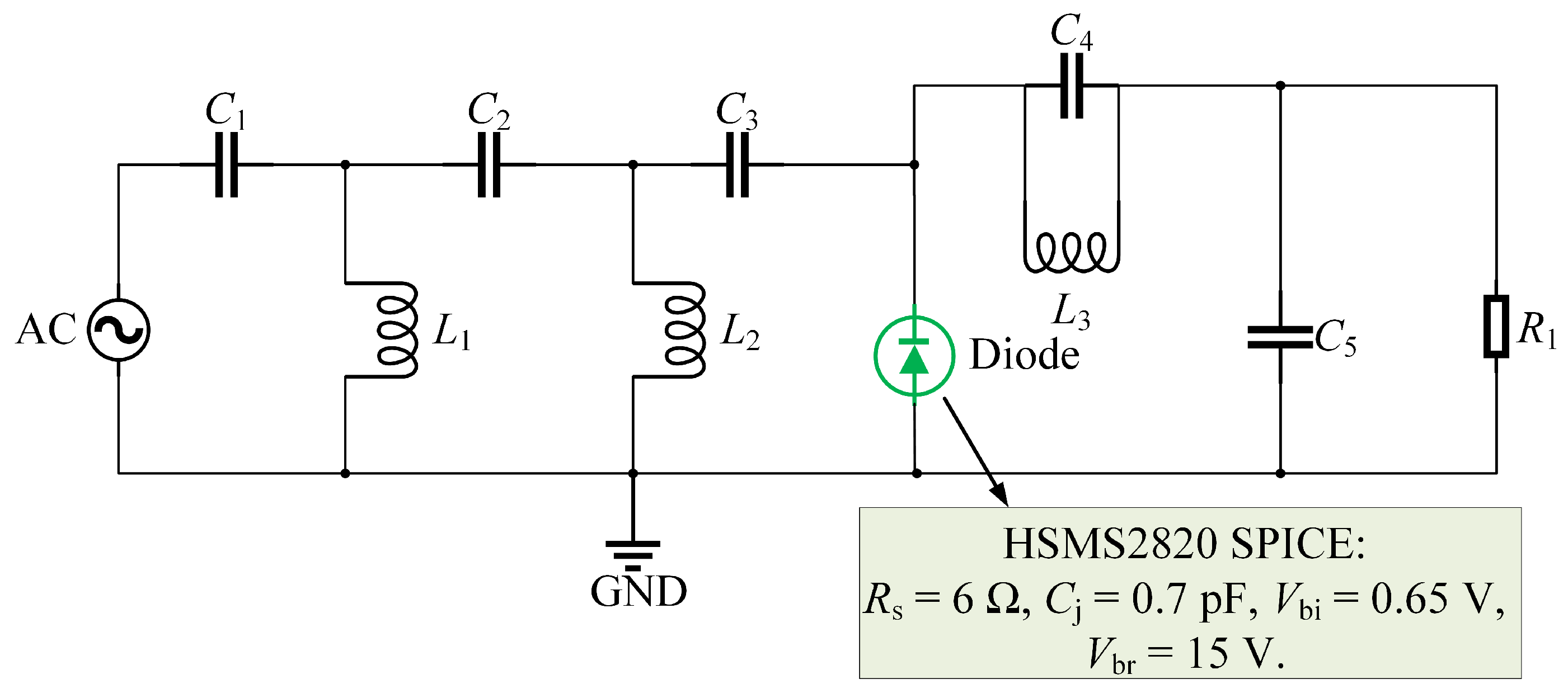
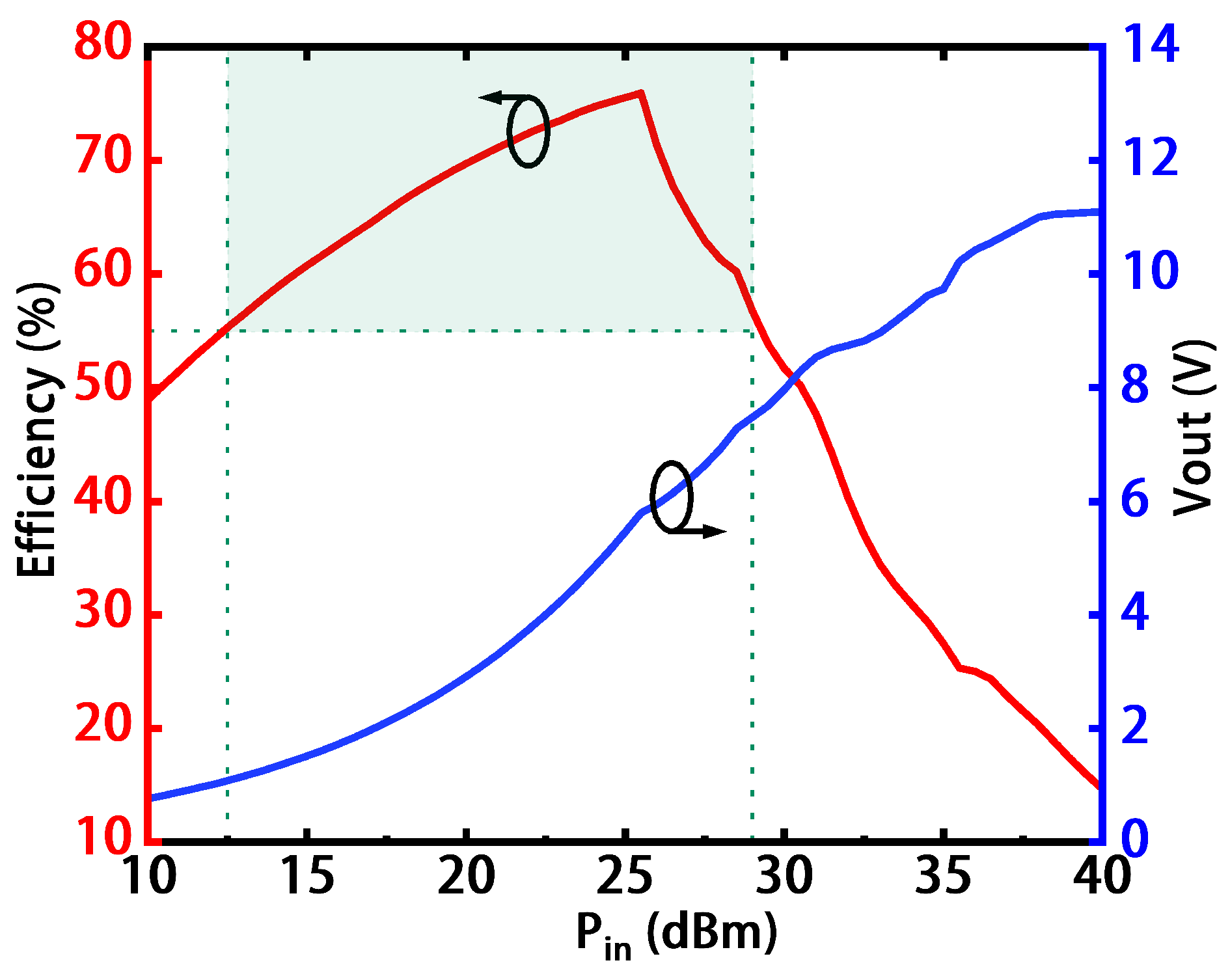
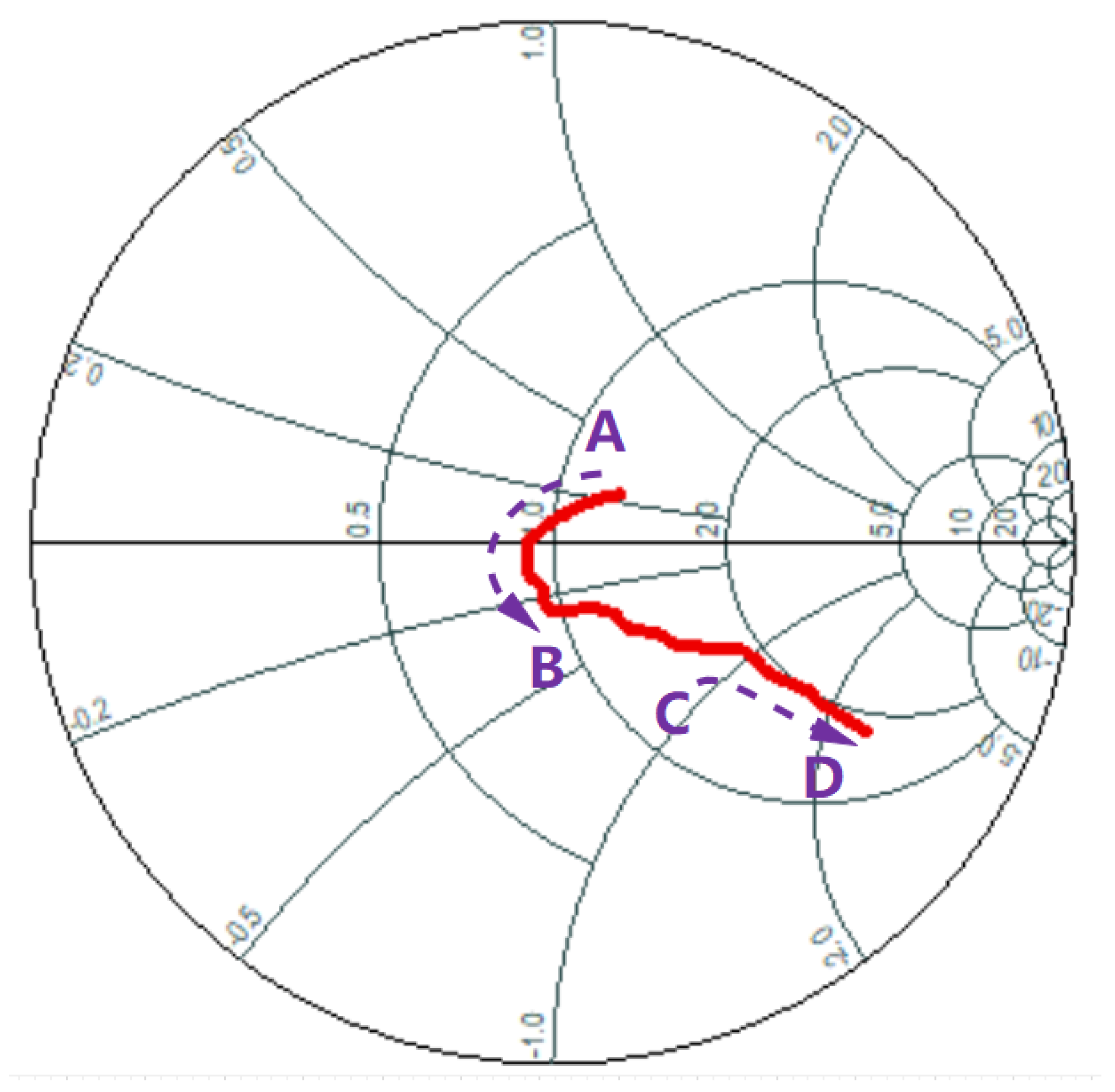
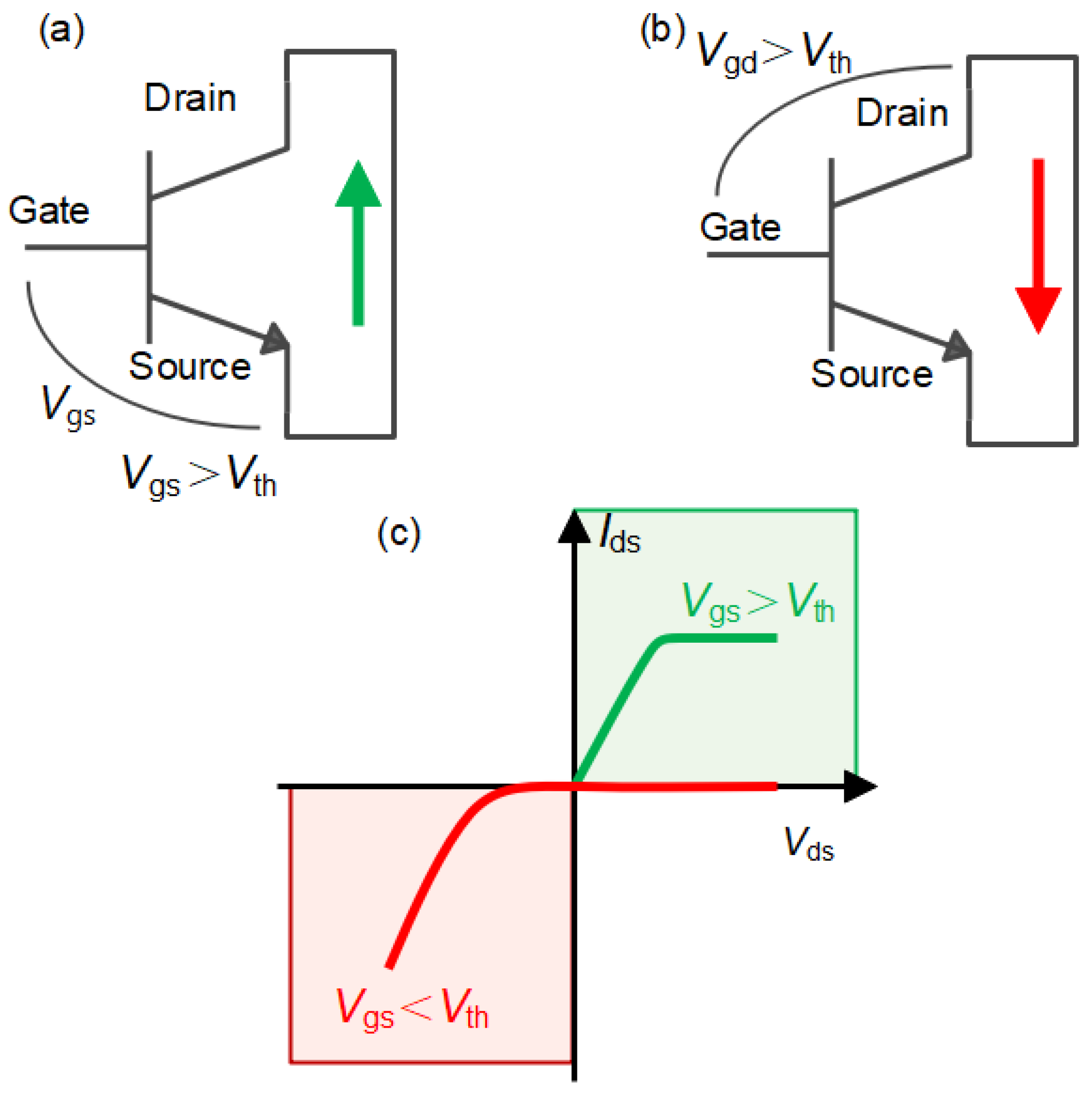
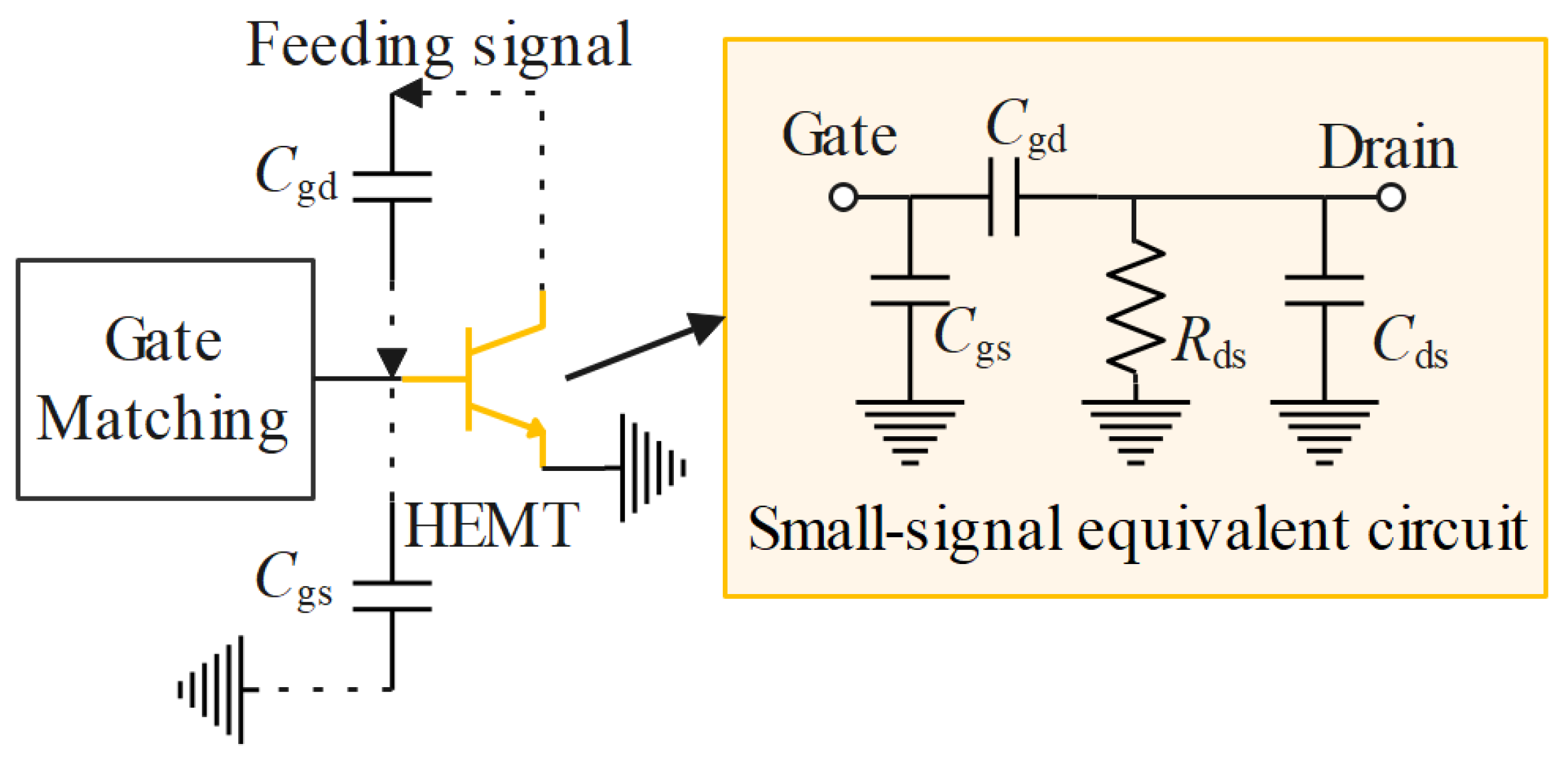
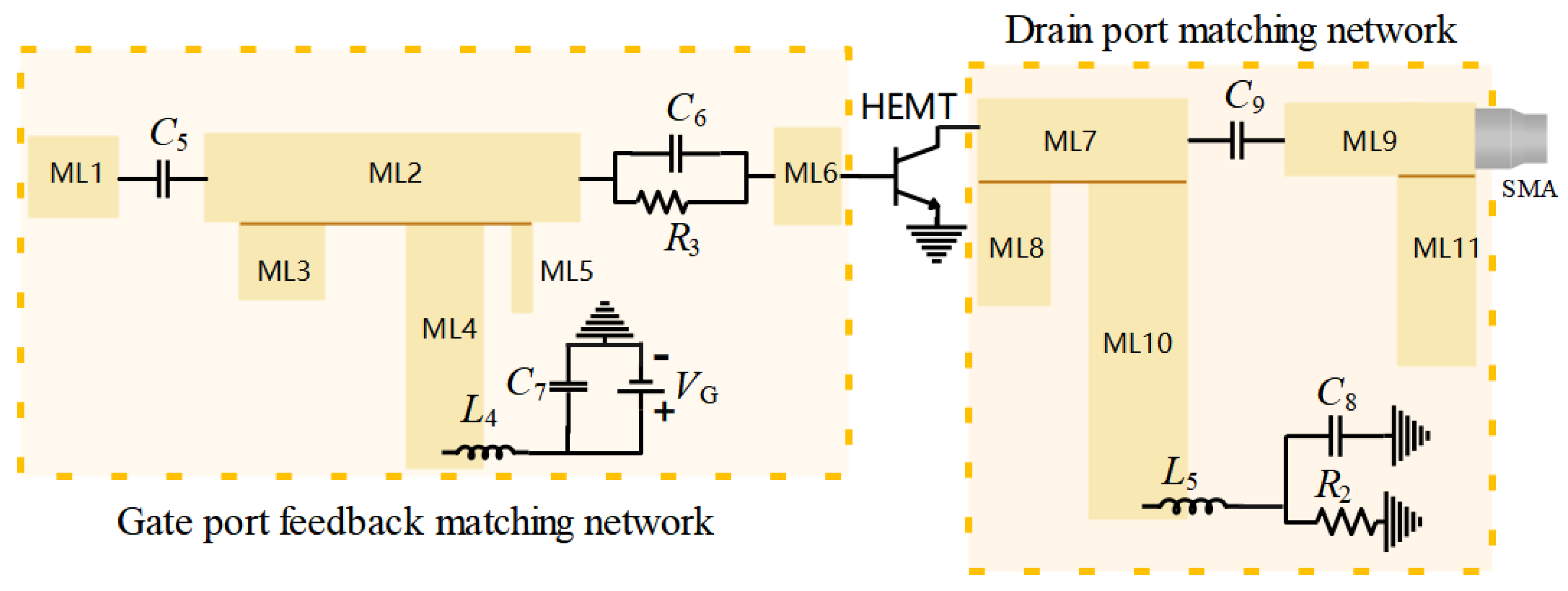
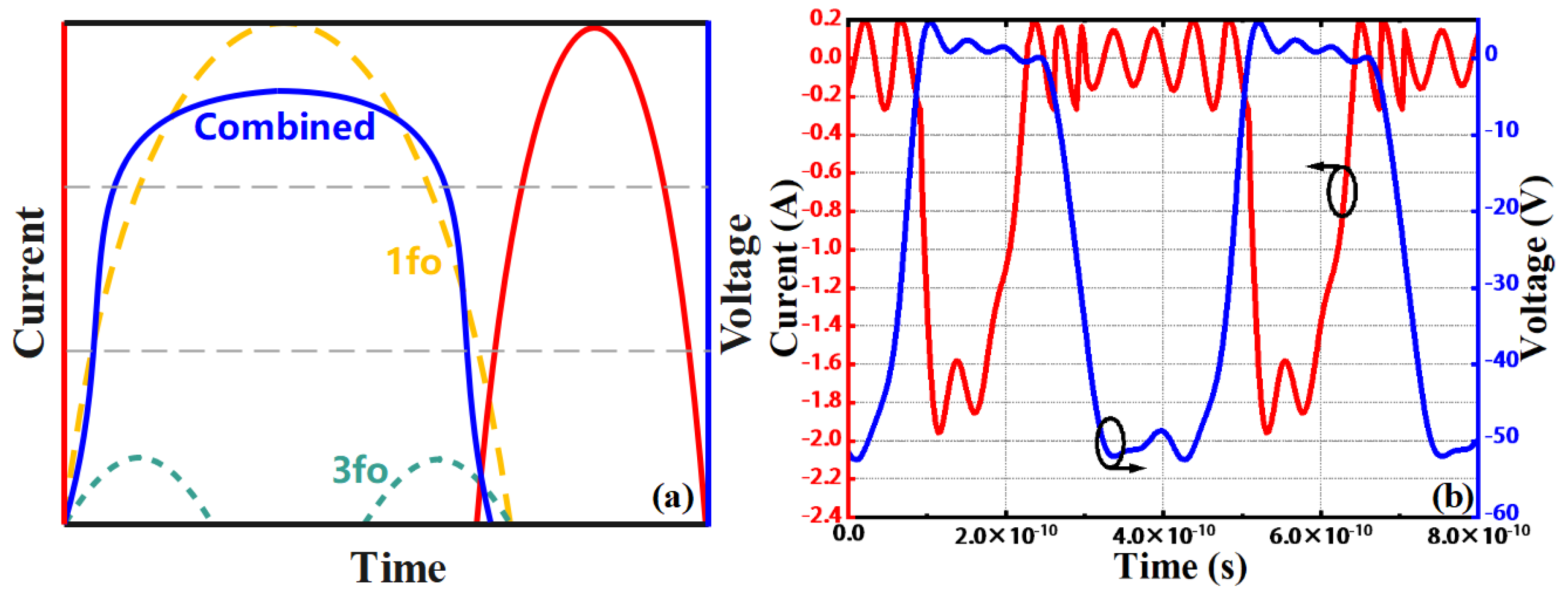
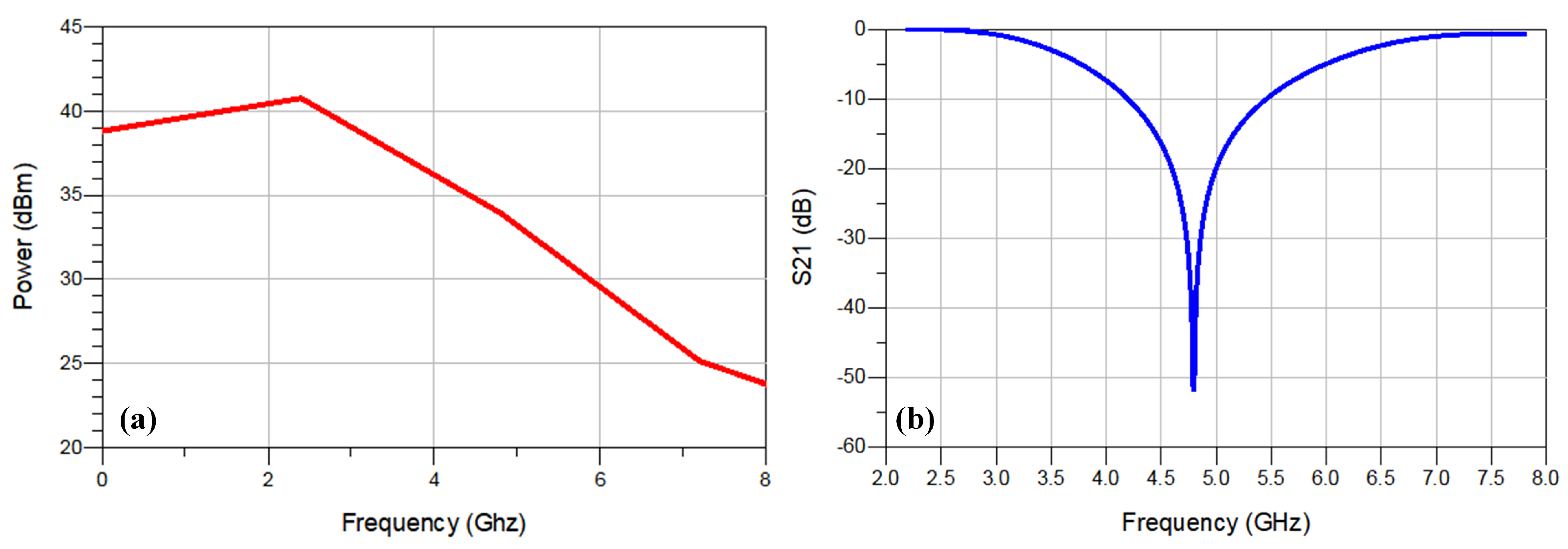
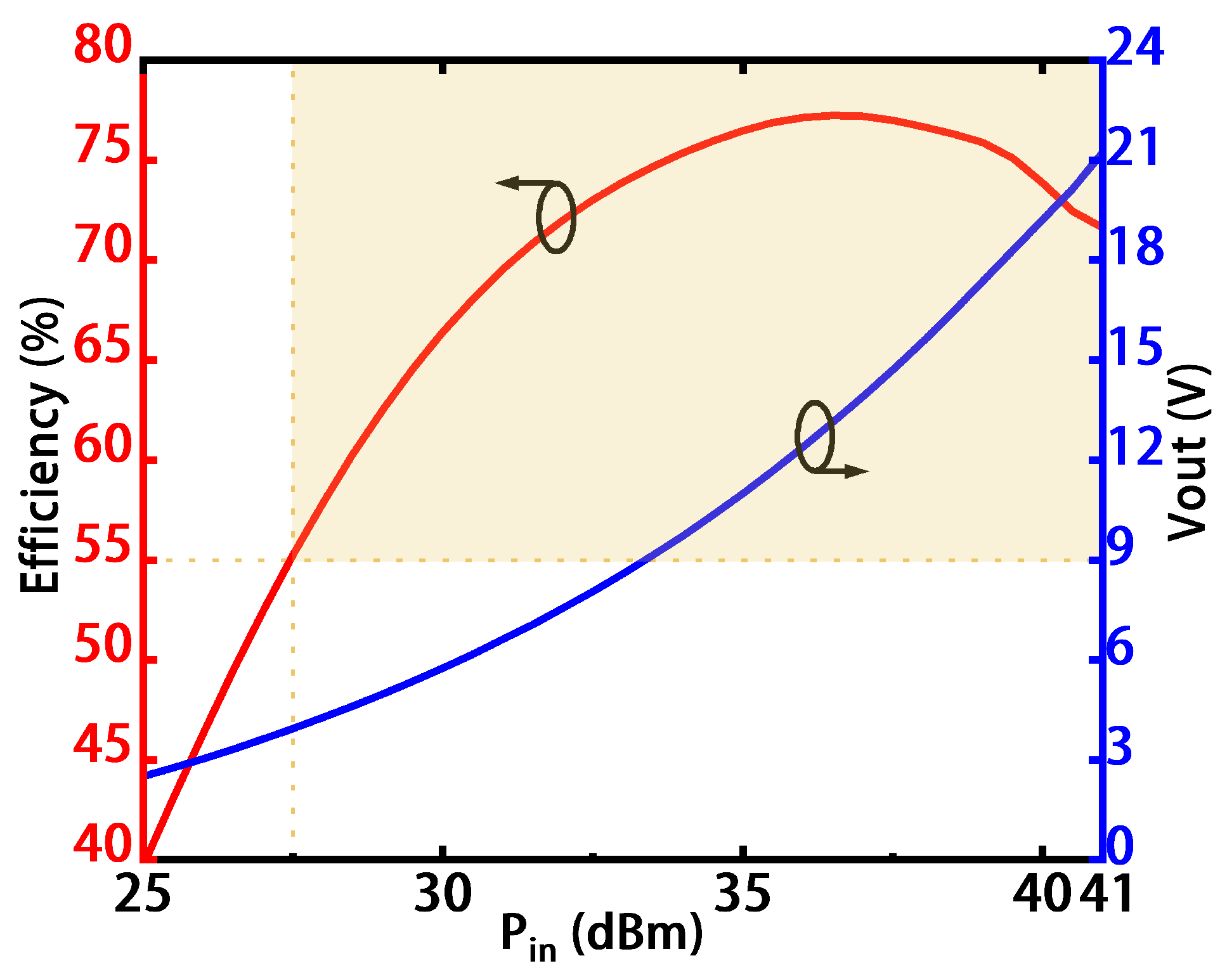


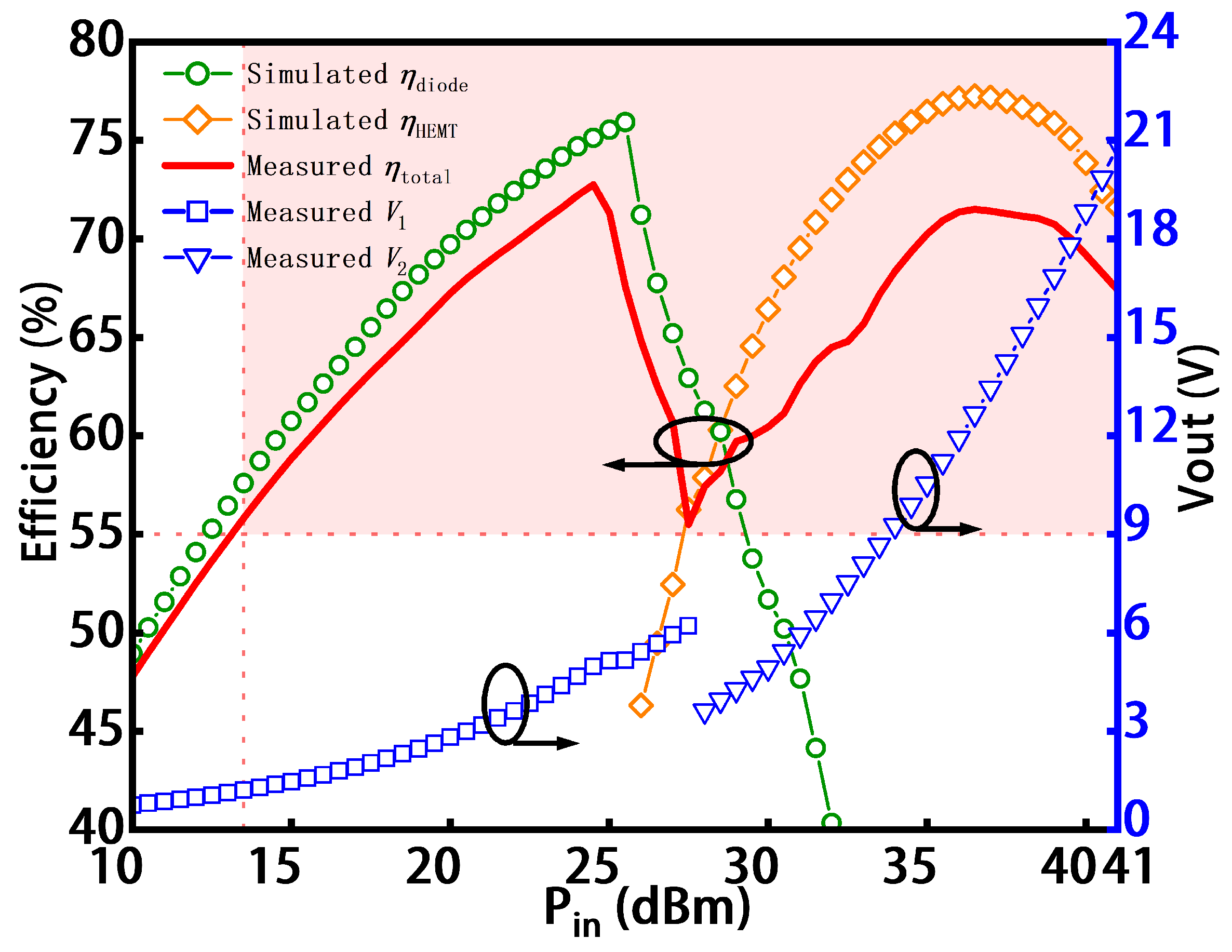
| Circuit Component | Value |
|---|---|
| 100 pF | |
| 0.7 pF | |
| 0.4 pF | |
| 2.7 pF | |
| 1.0 uF | |
| 3.4 nH | |
| 3.3 nH | |
| 1.4 nH | |
| 200 |
| Microstrip Line | Dimensions: mm × mm |
|---|---|
| ML1 | 3.9 × 3.29 |
| ML2 | 14.4 × 3.29 |
| ML3 | 3.6 × 3.29 |
| ML4 | 14.5 × 3.29 |
| ML5 | 5.4 × 1.00 |
| ML6 | 2.0 × 3.29 |
| ML7 | 10.3 × 4.50 |
| ML8 | 6.6 × 3.29 |
| ML9 | 10.5 × 3.29 |
| ML10 | 17.6 × 4.90 |
| ML11 | 9.6 × 3.29 |
| Reference/Year | Frequency (GHz) | Device | Topology | Peak Pin (W) | Peak PCE (%) | Pin Range (dB) for Efficiency over 55% |
|---|---|---|---|---|---|---|
| [27]/2023 | 2.6 | GaN HEMT | Class- phase shift | 10 | 86 | 17 |
| [28]/2022 | 1.9/2.4 | GaN HEMT | Class-F phase shift | 10 | 75/76 | 15/13 |
| [29]/2018 | 2.45 | 3 Schottky Diodes | Branch-line coupler | 1 | 62 | 24 (PCE > 50%) |
| [30]/2019 | 2.4 | 2 Schottky Diodes | Cooperative structure | 0.35 | 72.8 | 23 |
| [31]/2020 | 2.4 | 2 Schottky Diodes | Doherty concept | 1 | 81.2 | 22.5 |
| [32]/2021 | 2.45 | 4 Schottky Diodes | Doherty concept | 1.2 | 67.5 | 20.3 |
| This work | 2.4 | 1 HEMT & 1 Diode | Dual-model cooperation | 12.6 | 72.7 | 27.5 |
Disclaimer/Publisher’s Note: The statements, opinions and data contained in all publications are solely those of the individual author(s) and contributor(s) and not of MDPI and/or the editor(s). MDPI and/or the editor(s) disclaim responsibility for any injury to people or property resulting from any ideas, methods, instructions or products referred to in the content. |
© 2024 by the authors. Licensee MDPI, Basel, Switzerland. This article is an open access article distributed under the terms and conditions of the Creative Commons Attribution (CC BY) license (https://creativecommons.org/licenses/by/4.0/).
Share and Cite
Yu, X.; Zhang, J.; Liu, M.; Yang, X.; Huang, Y.; Yen, T.-J.; Zhou, J. Dual-Module Ultrawide Dynamic-Range High-Power Rectifier for WPT Systems. Energies 2024, 17, 2707. https://doi.org/10.3390/en17112707
Yu X, Zhang J, Liu M, Yang X, Huang Y, Yen T-J, Zhou J. Dual-Module Ultrawide Dynamic-Range High-Power Rectifier for WPT Systems. Energies. 2024; 17(11):2707. https://doi.org/10.3390/en17112707
Chicago/Turabian StyleYu, Xiaochen, Jinyao Zhang, Minzhang Liu, Xiantao Yang, Yi Huang, Ta-Jen Yen, and Jiafeng Zhou. 2024. "Dual-Module Ultrawide Dynamic-Range High-Power Rectifier for WPT Systems" Energies 17, no. 11: 2707. https://doi.org/10.3390/en17112707
APA StyleYu, X., Zhang, J., Liu, M., Yang, X., Huang, Y., Yen, T.-J., & Zhou, J. (2024). Dual-Module Ultrawide Dynamic-Range High-Power Rectifier for WPT Systems. Energies, 17(11), 2707. https://doi.org/10.3390/en17112707







